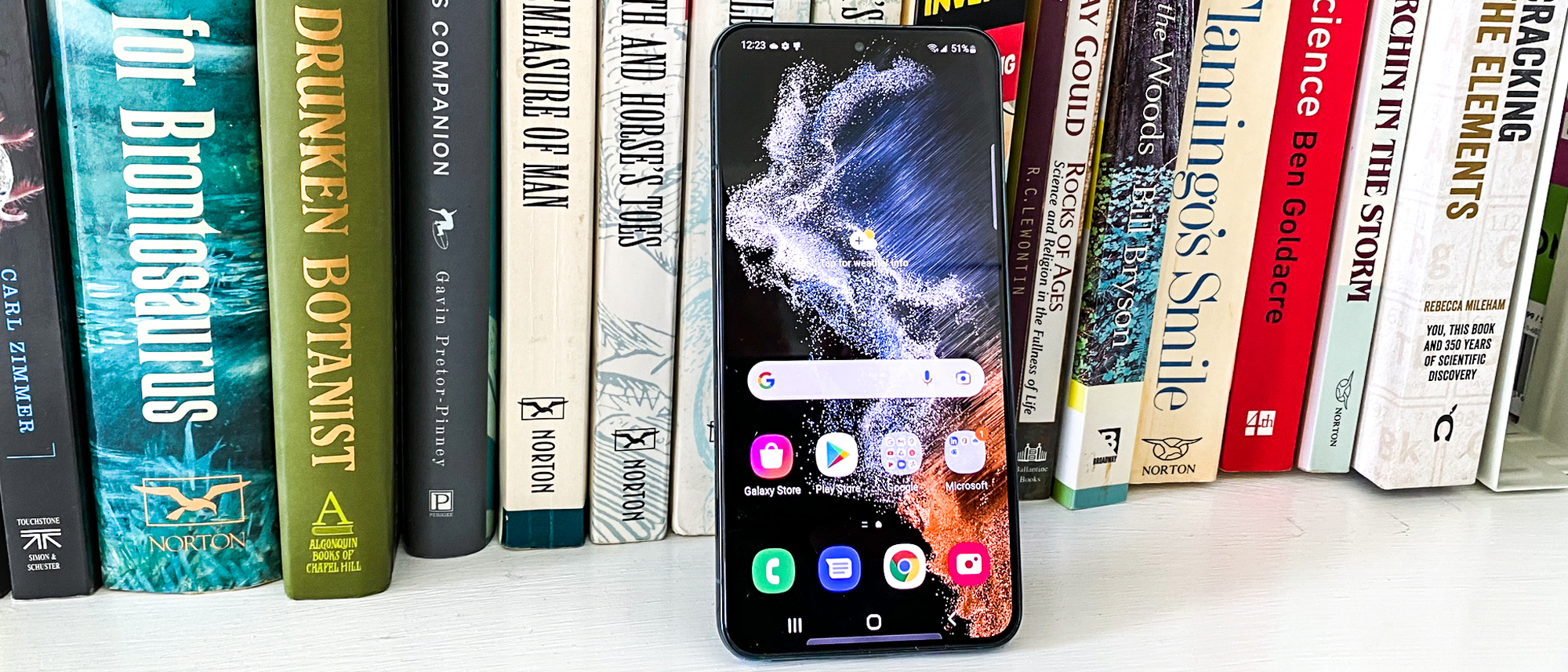Tom's Guide Verdict
The Galaxy S22 features modest if not earth-shattering improvements compared to its predecessor, and it's not all that different from the newer Galaxy S23, either. With Samsung dropping the price on the S22, this phone is a decent alternative to the pricier S23 lineup.
Pros
- +
Reduced price
- +
Bright, colorful display
- +
Improved zoom and low-light photos
- +
Solid performance
Cons
- -
Below-average battery life
- -
Photos can't match the leading camera phones
Why you can trust Tom's Guide
Starting price: $799
Screen size: 6.1-inch AMOLED (2340 x 1080)
Refresh rate: 48Hz - 120Hz (adaptive)
CPU: Snapdragon 8 Gen 1 (US); Exynos 2200 (UK)
RAM: 8GB
Storage: 128GB, 256GB
Rear cameras: 50MP wide (f/1.8); 12MP ultrawide (f/2.2); 10MP telephoto (f/2.4) with 3x optical zoom
Front camera: 10MP (f/2.2)
Battery size: 3.700 mAh
Battery life: (Hrs:Mins): 7:52
Size: 5.7 x 2.8 x 0.3 inches
Weight: 5.9 ounces
Colors: Phantom Black, Phantom White, Green, Pink Gold, Bora Purple
Even the arrival of the Galaxy S23 isn't enough to completely obscure the Samsung Galaxy S22. When it came out in 2022, the Galaxy S22 felt like the most underrated part of the S22 lineup, lacking the premium features of the Galaxy S22 Ultra and the larger screen of the Galaxy S22 Plus, but delivering plenty of value thanks to its lower price tag and comparable specs.
That value has only increased with age, as Samsung kept the Galaxy S22 in its lineup, but lowered the price by $100. That means if the Galaxy S23's $799 cost is a little hard to swallow, you can opt for the older Galaxy flagship and keep an extra $100 in your wallet.
You'll find newer options among the best Samsung phones, but you won't find a more affordable Galaxy S model (at least until the rumored Galaxy S23 FE comes along). This is no longer the model of choice for everyone, especially those who want every premium feature packed into a phone. But our Samsung Galaxy S22 review finds a phone with enough high-end features to impress as one of the best Samsung phones, especially at its now-reduced price.
Samsung Galaxy S22 review: Price and availability
The Galaxy S22 has been on sale for about a year. You'll still find it at every major wireless carriers, as well as a few MVNOs like Google Fi, Xfinity Mobile and Visible. Retailers such as Amazon and Best Buy sell the phone, too, and you can buy it directly at Samsung.com, where the Galaxy S22 is also available in some Samsung-exclusive colors. (Three of the four exclusive options are out of stock as of this writing, though.)
Originally available for $799, the Galaxy S22 has since been permanently reduced to $699 by Samsung. Top Galaxy S22 deals and our Samsung promo codes let you save even more on the cost of the phone.
The base model of the Galaxy S22 offers 128GB of storage, and another $50 will bump that to 256GB.
To put the Galaxy S22's price in context, Samsung's entry-level flagship debuted at the same price Apple now charges for the iPhone 14. The $599 Pixel 7 is cheaper, though it lacks a telephoto lens like the one on the S22.
Samsung Galaxy S22 review: Design
After experimenting with a polycarbonate back for the Galaxy S21, the Galaxy S22 sports an upgrade in materials, with an aluminum band around the middle and a glass back that's made out of Gorilla Glass Victus Plus. That should bolster durability, though dropping glass of any kind onto hard surfaces can lead to disastrous consequences — we'd recommend getting one of the best Galaxy S22 cases to protect your new phone. At least those improved materials make the Galaxy S22 feel like a more sophisticated phone than the plastic Galaxy S21 FE or some other discount handsets
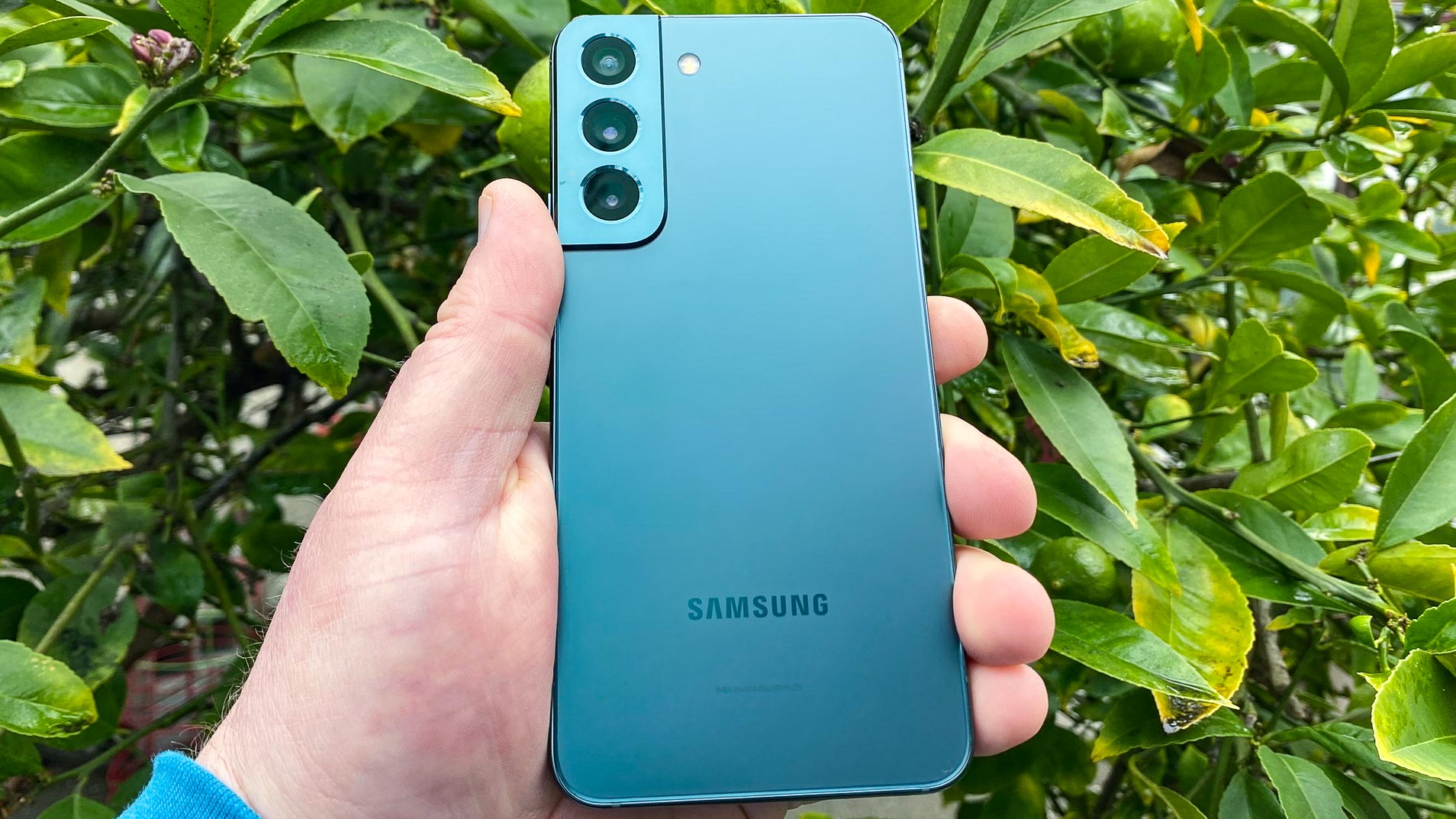
The materials may be different from previous Galaxy S flagship, but the design is the same, right down to the contour cut look for the rear camera array, in which the three vertically stacked lenses on the back of the phone are contained in a bump that blends into the device's side. The difference here is that Galaxy S21's camera array was a different color from the rest of the phone's back; on the Galaxy S22, Samsung matches colors.
As for those colors, you get the same choices available to the Galaxy S22 Plus — Phantom Black, Phantom White, green and pink gold. Ordering directly from Samsung expands your color options.
In July 2022, Samsung introduced a new Bora Purple color for the Galaxy S22, and it is a pretty striking hue on this device.
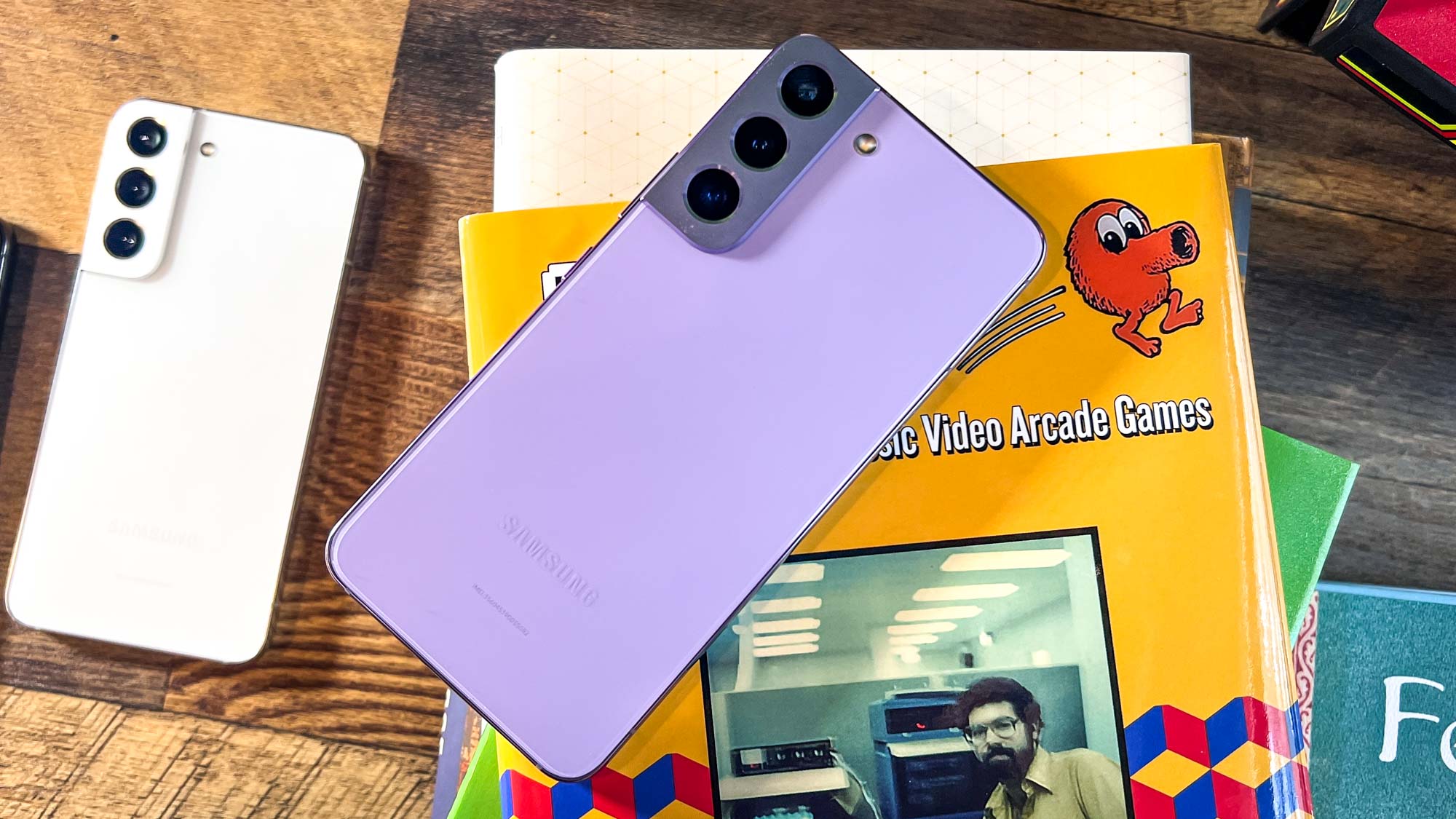
Though the Galaxy S22 houses a 6.1-inch display — smaller than the 6.2-inch panel on the S21 — I'm struck by how compact the phone feels. It's certainly easy to use with one hand and comfortably enough to slip into a pocket. If, like me, you've shied away from big phones because you've found them too unwieldy, that's certainly not a problem with the Galaxy S22.
Samsung Galaxy S22 review: Display
Samsung looked to improve display brightness across the board on the Galaxy S22 lineup. And while the Galaxy S22 Plus and S22 Ultra get the better end of the deal with a peak brightness of 1,750 nits, the S22's 1,300-nit peak brightness is nothing to sneeze at. (The Galaxy S23, in contrast, does match that 1,7500 nit brightness.
In SDR, we used a light meter to measure peak brightness at 672 nits, though with HDR turned on, that reading reached 1,152 nits. To put those numbers in context, the iPhone 13 hit 795 nits of brightness when we tested that display. The Galaxy S23 is only slightly brighter at 1,158 nits.
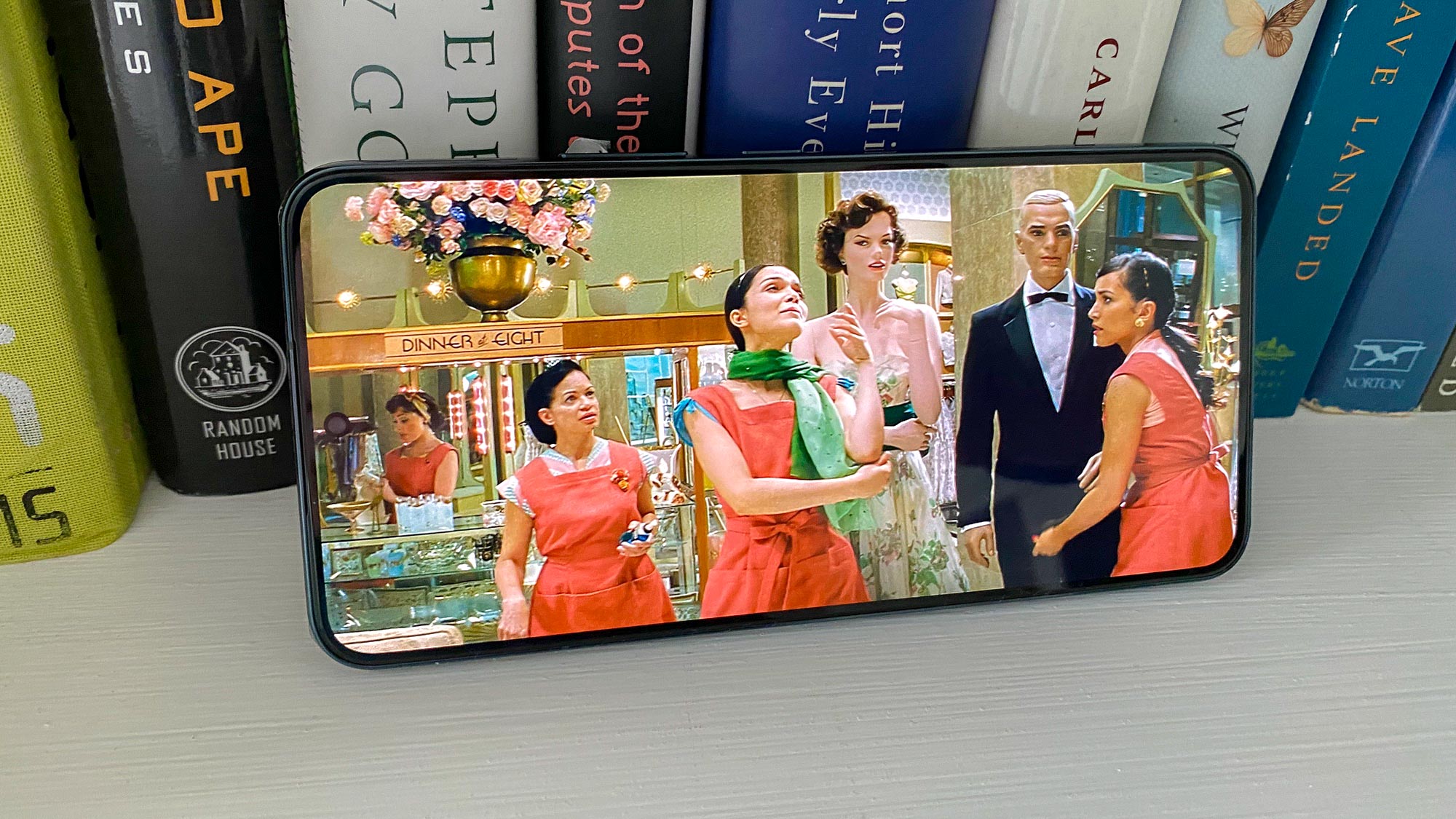
In practical terms, you won't struggle to see the Galaxy S22 screen in bright sunlight, though you may have to crank up the brightness all the way to get every detail. When you do, Samsung's Vision Booster technology not only adjusts brightness but also color contrast so that colors aren't washed out at the expense of a more visible screen. The feature certainly allowed me to double-check the sample photos I was snapping on a bright, sunny day without compromising color.
Speaking of colors, they're pretty vivid on the Galaxy S22's AMOLED panel. When set to Natural mode, the S22's display shows off 110% of the sRGB color spectrum, matching the iPhone 13's output. You can get even more colors on the S22 screen by opting for Vivid mode, though that will come at the expense of color accuracy. As it stands, the S22's 0.25 Delta-E rating in Natural mode edges ahead of the iPhone 13's 0.26 score. (Numbers closer to zero are more accurate.)
You certainly won't be disappointed when watching videos on the Galaxy S22's screen, which proved more than capable handling the shifting tones of Steven Spielberg's West Side Story remake. Likewise, even the more shadowy scenes from the Cyrano trailer on YouTube were highly detailed, thanks to the way the S22 panel handled inky blanks and stylized lighting.
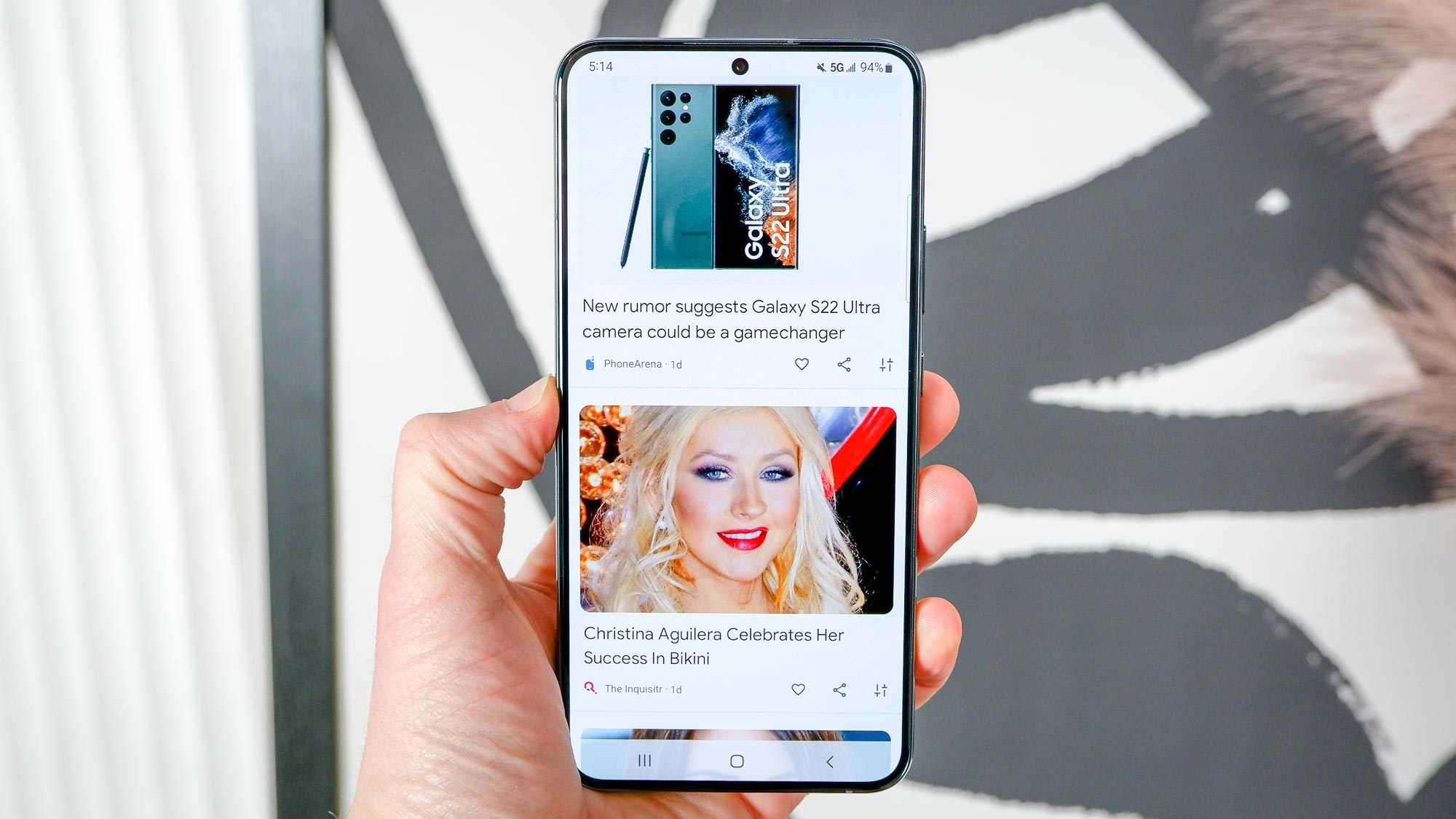
The Galaxy S22 holds one other edge over phones in its price range such as the iPhone and the Pixel. Samsung has opted for a 120Hz refresh rate, which means smoother scrolling when compared to phones like the iPhone 14, which is fixed at 60Hz. Even the Pixel 7's 90Hz refresh rate doesn't measure up to what the Galaxy S22 offers. (The same was true when the S22 competed with the iPhone 13 and Pixel 6.)
What's more, the Galaxy S22 can scale all the way down to 48Hz when the on-screen action is static as a way to preserve battery life. We recently compared the Galaxy S22 display to the screens on the iPhone 14 and Pixel 7 — the Galaxy S22 won our display face-off.
Samsung Galaxy S22 review: Cameras
The Galaxy S22 features the same basic camera setup that Samsung used for the Galaxy S21, but with some notable improvements to the hardware. The main camera now has a 50MP rating instead of the 12MP wide-angle shooter used in last year's phone. The sensor is 23% larger, too, to let in more light, as Samsung makes a push to improve camera performance in low light.
To see just how well the Galaxy S22's cameras performed, I put Samsung's new phone up against the Google Pixel 6 and iPhone 13. (For more photo comparisons, plus an overall look at how these phones compare, you can read our Galaxy S22 vs. Pixel 6 and Galaxy S22 vs. iPhone 13 face-offs; we've also got iPhone 14 vs Samsung Galaxy S22 and Google Pixel 7 vs. Galaxy S22 face-offs with comparisons to newer models.)
The Galaxy S22 certainly managed to capture a lot of detail in this photo of some Star Wars tiki mugs in a darkened corner of my kitchen. You can really spot the holes in the black slotted spoon I have stored in the Jawa mug — a detail the iPhone 13's camera wasn't able to pick up. However, there's a problem with color in the S22 shot that I'd chalk up to white balance issues; though it's not as detailed, the iPhone 13 shot has a better balance to it with more realistic colors.
The Galaxy S22 fared a little bit better when I tested it against the Pixel 6, a top Android option among the best camera phones. This fruit stand proved to be a challenging shot with the covered stand in the foreground being backlit by a bright, sunny day in the outside world. The Pixel 6 struggles to balance that light streaming in from behind, and the result is a shadowy image where the apples and melons fail to stand out. Those fruits are much more vivid in the Galaxy S22 photo, and the sunlight-bathed background provides a good contrast to the shot.
The Galaxy S22's focus on what Samsung calls "Nightography" extends to the night mode, which managed a fairly detailed shot of some stuffed animals sitting on a bench, with only a nearby porch light illuminating the scene. You can make out each stuffed animal in this poorly-lit trio, with even the black bear managing to emerge from the darkness in the Galaxy S22 shot. The Pixel 6's effort leaves the bear in shadows. That said, the Galaxy S22 struggles with color — the house in the background is too muddled in Samsung's photo, and the green on Kermit's legs has a too bright sheen that the Pixel 6 manages to avoid.
I'm generally pleased with how the Galaxy S22 cameras perform in low-light and no-light. But the photos aren't notably better than what other camera phones produce, and Samsung's well-documented issues with over-exposed colors remain with the S22.
As an example, check out this photo of a frog statue that I shot in broad daylight. Both the S22 and iPhone 13 efforts are solid enough — but the iPhone 13 does just a little bit better handling the different colors. The tone of the green ice plants surrounding the frog isn't as saturated, and the purple flowers are a touch brighter. The frog also looks a little washed-out in the Galaxy S22's shot compared to the deeper colors the iPhone 13 managed to capture.
The main lens isn't the only one to see changes with the Galaxy S22. Samsung also changed things up with the telephoto lens, downgrading the sensor from 64MP to 10MP but opting for a 3x optical zoom instead of the hybrid zoom it used on the Galaxy S21. The result is sharper, more detailed shots when you zoom in for a closer look.
Consider this photo of the Oakland skyline taken at the maximum 3x optical zoom for the Galaxy S22 and using a digital zoom for the Pixel 6, since Google's phone isn't equipped with a telephoto lens. Indeed, the zoom capability on the Galaxy S22 is its best feature, as you won't find many phones with a telephoto lens at this price.
The Galaxy S22 photo is understandably sharper, while the Pixel 6 can only manage to keep the boats in the foreground in focus. Everything else is a little fuzzy.
But the differences really stand out as you zoom further in. The Pixel 6 maxes out a 7x zoom and while it's a decent photo, you have to live with a lot of noise and a lack of definition. The Galaxy S22 is once again more detailed — you can make out the letter on the Tribune building, for example — and the blue sky isn't as grainy as it is in the Pixel 6 shot.

If you want, you can keep going on the Galaxy S22, zooming all the way to 30x with the help of the phone's Super Resolution Zoom feature. You'll want to use a tripod for a steady shot, as this close-up of Tribune Tower turned pretty jittery as I struggled to keep everything in focus.
The 12MP ultrawide camera on the Galaxy S22 appears to be unchanged, but you won't hear me complaining if photos like this one taken at my local decommissioned naval air station are the result. The jet stands out nicely against the blue sky — I think this is the rare example where the Galaxy S22 does a better job with color than the iPhone 13, which darkens the blue a little too much. It's just a well-balanced shot that makes perfect use of the ultrawide angle lens' 120-degree field of view.
Samsung touts an AI Stereo Depth Map feature for Portrait mode shots in which artificial intelligence better separates subject from background. We put the Galaxy S22's Portrait capabilities to the test in a Portrait mode face-off featuring several rival phones, but this photo of my daughter is illustrative of what Samsung brings to my table. She seems to pop out from the orange tree she's standing in front of in the S22's photo, which also lacks the slight halo effect that's visible around her headband in the iPhone 13 portrait. That said, I appreciate the warmer skin tones in the iPhone's shot.
I kept the portrait effect turned on when testing a selfie taken by the Galaxy S22's 10MP front camera. Again, Samsung's camera phone does a good job separating me from the background, but the picture is more washed out than what the Pixel 6 produced. Perhaps my skin isn't as ruddy as what Google's phone captured, but the shot is certainly warmer and the one I'd be incline to share.
The cameras have clearly improved on the Galaxy S22, particularly when it comes to low-light shots and portrait pictures. The trouble for Samsung is that its leading competitors on the camera phone front — Apple and Google — haven't stood still, either. As good as the cameras on the Galaxy S22 are, Samsung still has some catching up to do in terms of color if it wants to overtake its rivals.
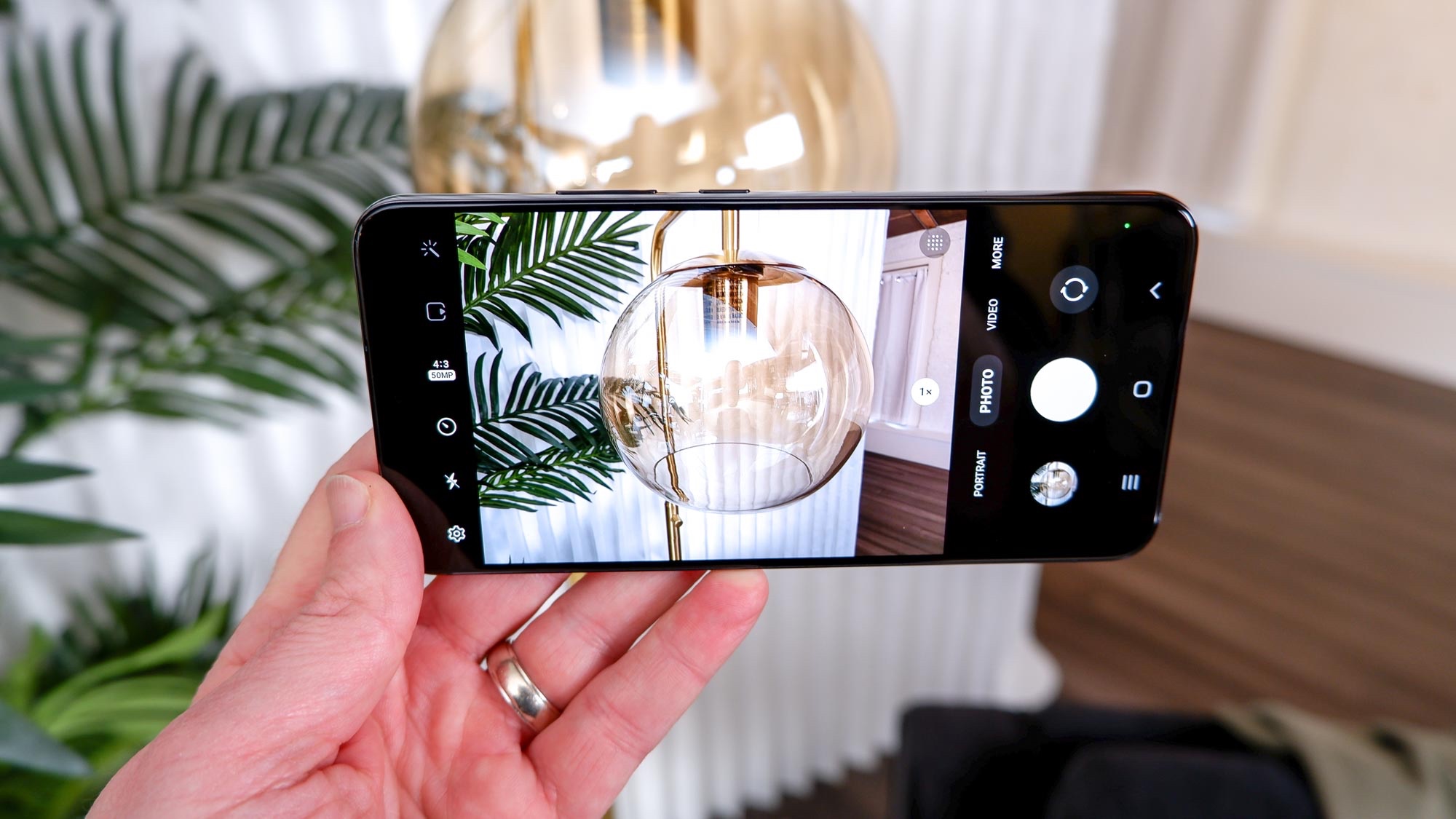
I'd be remiss if I didn't mention the Galaxy S22's video capture capabilities. The phone can capture 8K video recording at 24 frames per second and 4K video at 60 FPS. Video Digital Image Stabilization promises steady footage with minimal shake, and an Auto Framing capability can detect and track up to 10 people, automatically shifting focus.
One interesting thing to note about the Galaxy S22's photography is that it differs slightly between countries due to the different chipsets Samsung uses. You can read more about that in our report on some recent Galaxy S22 Ultra camera testing.
It's also worth noting that Samsung releases software updates that can fine-tune the photo processing of its phones, among other things. The June 2022 software update, for example, promises improved sharpness and contrast for photos; Portrait Mode also saw a boost, and Samsung says it improved memory utilization when you're capturing video.
Samsung Galaxy S22 review: Performance
Because I'm testing the Galaxy S22 in the U.S., my version of Samsung's phone is powered by the Snapdragon 8 Gen 1, the same chipset found in other S22 models. In other parts of the world, Samsung uses its own Exynos 2200 chipset, though our Galaxy S22 Plus benchmarks indicate similar performance regardless of the silicon.
That's good news in one sense, as the Snapdragon 8 Gen 1 powers some of the best performance we've seen from an Android phone — at least for a phone released in early 2022. Since then Qualcomm released the more advanced Snapdragon 8 Plus Gen 1 — it powers the Galaxy Z Fold 4 and Galaxy Z Flip 4 — and then there's the Snapdragon 8 Gen 2 in the Galaxy S23 family that brings another big peformance boost.
But let's concentrate on what the Snapdragon 8 Gen 1 means for the Galaxy S22. On Geekbench 5, which measures general performance, our Galaxy S22 produced single- and multicore scores of 1,204 and 3,348, respectively. That's better than the Tensor-powered Pixel 6 and its 1,029 and 2,696 results on those same tests. The OnePlus 10 Pro, released after the Galaxy S22 came out, outperforms Samsung's phone in Geekbench 5's multicore test with a score of 3,482, but OnePlus tends to pack its phones with RAM
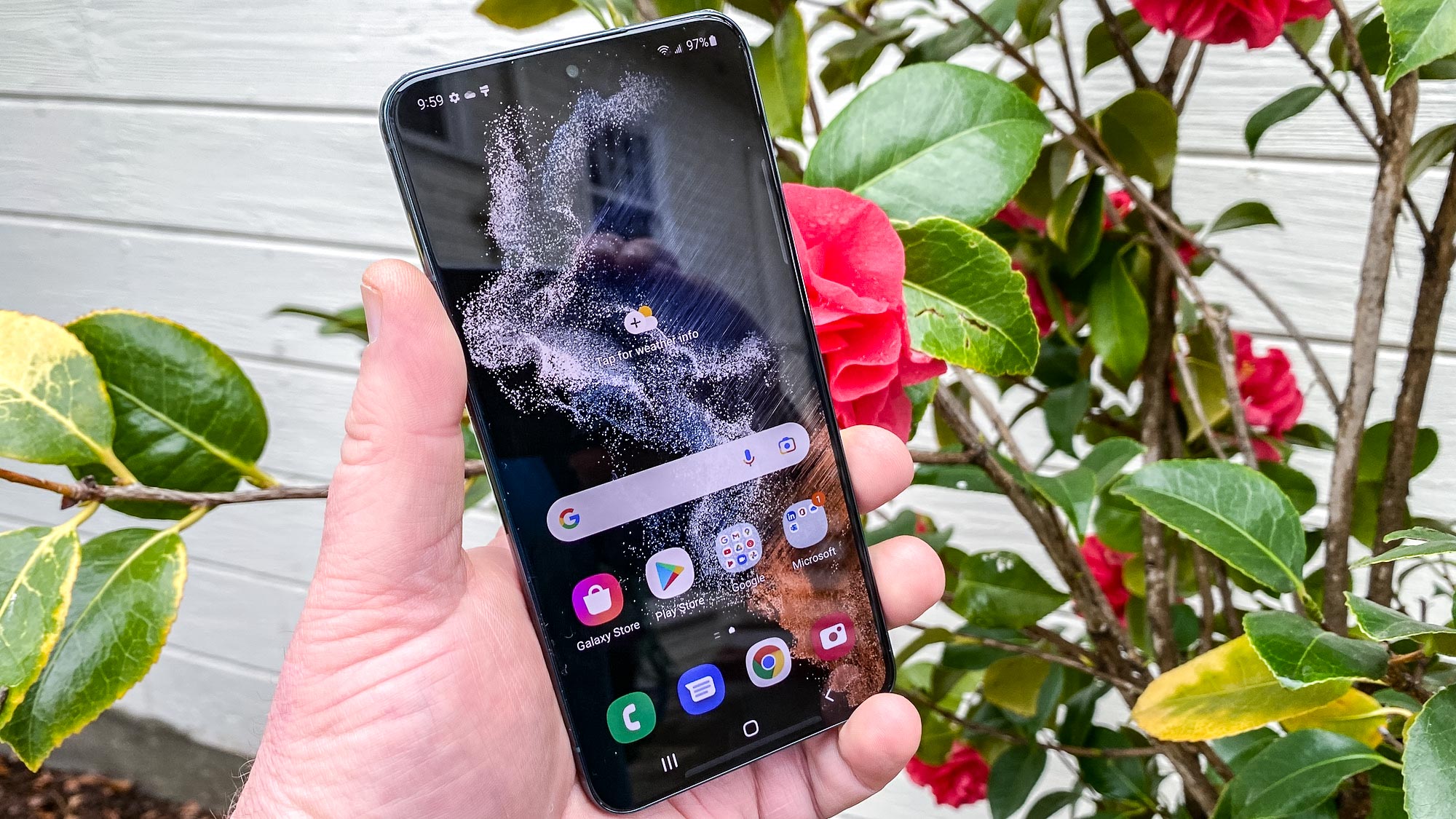
The problem for Samsung — and indeed for all Android phone makers — is that Apple's mobile silicon remains the better performer. On Geekbench, the iPhone 13 posted a 1,684 single-core score and a 4,129 multicore result, blowing the Galaxy S22 away.
The gap has only grown with the release of the iPhone 14, which runs on a modified version of the A15 Bionic that powered the iPhone 13, and the iPhone 14 Pro, which features an even faster A16 Bionic. While the Galaxy S22 can still hold its own against most Android phones, any recent iPhone outmuscles Samsung's one-time flagship.
The results are much better in graphics testing where the Galaxy S22 produced a 60 FPS result in 3DMark's Wild Life Unlimited test. That's better than the iPhone 13's 56 FPS result and well ahead of the 34 FPS the Pixel 6 produced.
Samsung phones have traditionally struggled with one of our real world tests in which we use Adobe Premiere Rush to transcode a 4K video into 1080p. It took last year's Galaxy S21 more than 1 minute to finish the task, but the Galaxy S22 improves that time to 47 seconds. That's still longer than the iPhone 13's 26-second time, but faster than the 49-second result the Pixel 6 turned in. The Galaxy S23 shaves another 8 seconds off the S22's time, with the help of its more advanced processor.
Samsung is all in on 5G, with the Galaxy S22 able to connect to both mmWave and sub-6GHz networks. The Galaxy S22 uses a Snapdragon X65 modem, which is Qualcomm's top-of-the-line modem until the X70 starts shipping toward the end of 2022.
Samsung Galaxy S22 review: Battery life and charging
The size of the screen isn't the only thing to shrink from the Galaxy S21 to the Galaxy S22. There's also a smaller battery in this year's model — a 3,700 mAh power pack instead of a 4,000 mAh one. Perhaps Samsung was hoping that a more efficient chipset and another year of an adaptive display would improve battery life on the Galaxy S22. If so, it was a big miscalculation.
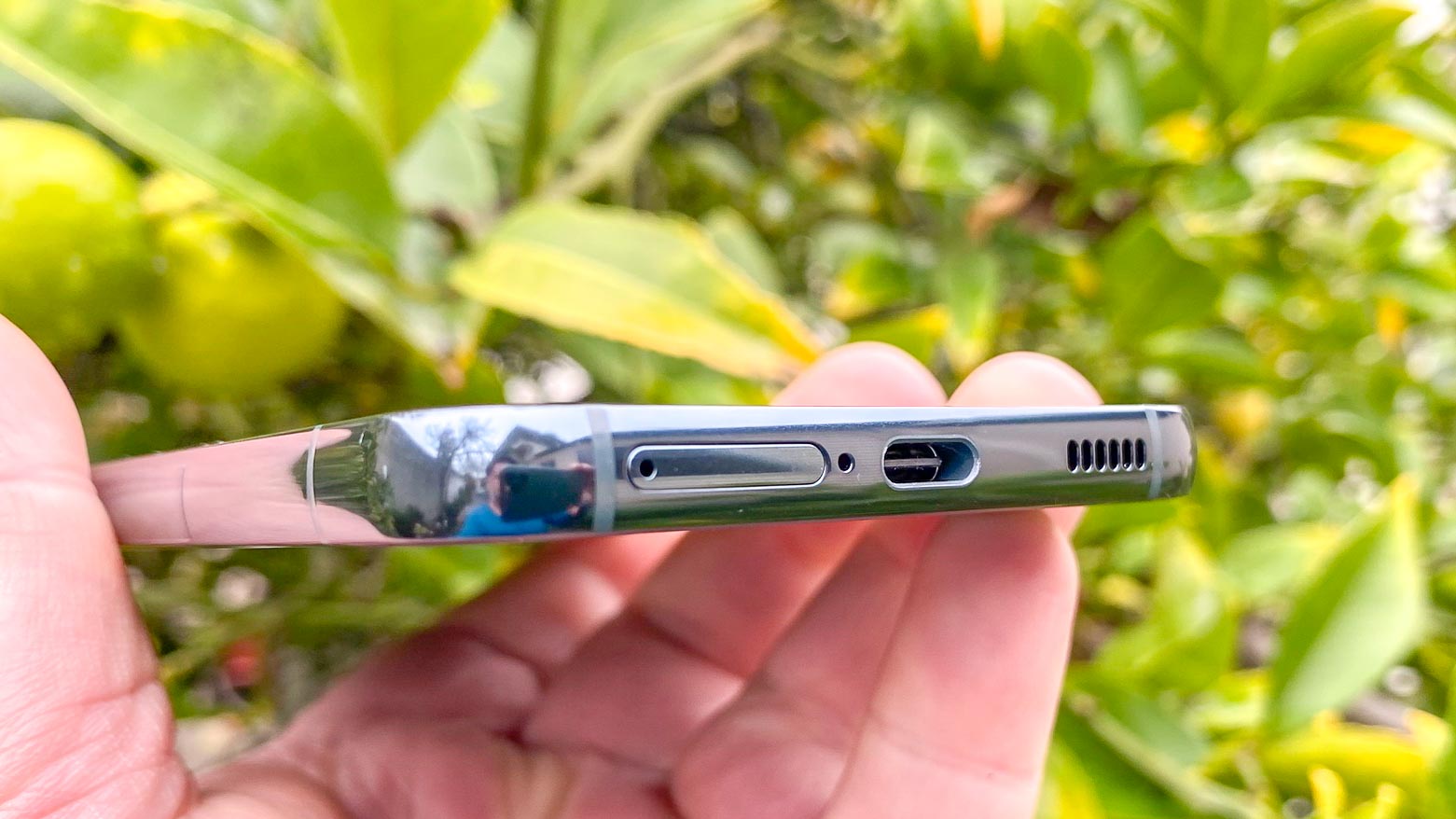
Like every phone we test, we set the Galaxy S22's screen to 150 nits and had it surf the web over cellular — 5G, in this case — until it ran out of power. The results did not impress, as the Galaxy S22 managed 7 hours and 51 minutes of battery life — a little more than two hours worse than the average smartphone. Turning off adaptive refresh rate improved matters a little, with an average time of 8 hours and 2 minutes, though that's still short of what we'd expect from a premium phone like the Galaxy S22.
You only have to look at the Galaxy S23 to see how Samsung missed the mark with battery life on the Galaxy S22. The newer flagship rides the power efficiency of the Snapdragon 8 Gen 2 chipset to a 10 hour, 27 minute result — and that's with the adaptive refresh rate on the display turned on. That 2.5-hour difference in battery test results is one reason to pay up for the Galaxy S23 over the Galaxy S22.
In terms of everyday use, the Galaxy S22 will get your through the day. An intensive couple of hours of testing that involved gaming, video streaming and other activities that tested the phone's refresh rate, dropped the battery from 97% to 77%. That's all right, though Apple's phones last longer. (The iPhone 13 held out for 10.5 hours on our battery test.)
The Galaxy S22 misses out on the big improvements enjoyed by the S22 Plus. That larger phone supports 45W wired charging, while the Galaxy S22 makes do with 25W. Consequently, a drained Galaxy S22 can get to a 60% charge after half-an-hour, while the S22 Plus is already at 70%, even with a bigger battery to fill. That's still faster than the iPhone, which can get to a 51% charge after 30 minutes.
Samsung Galaxy S22 review: Software and special features
The Galaxy S22 debuted with Samsung's One UI 4.1 interface for Android 12, but Android 13 should now be available through Samsung's One UI 5 update. In fact, the One UI 5.1 update that debuted with the Galaxy S23 should be available for the Galaxy S22 at this point.
With the Galaxy S22 series, Samsung and Google brought a live sharing feature to Google Duo that lets you view photos and take notes with the people on a video call — kind of like what Apple added via iOS 15's Share Play feature.
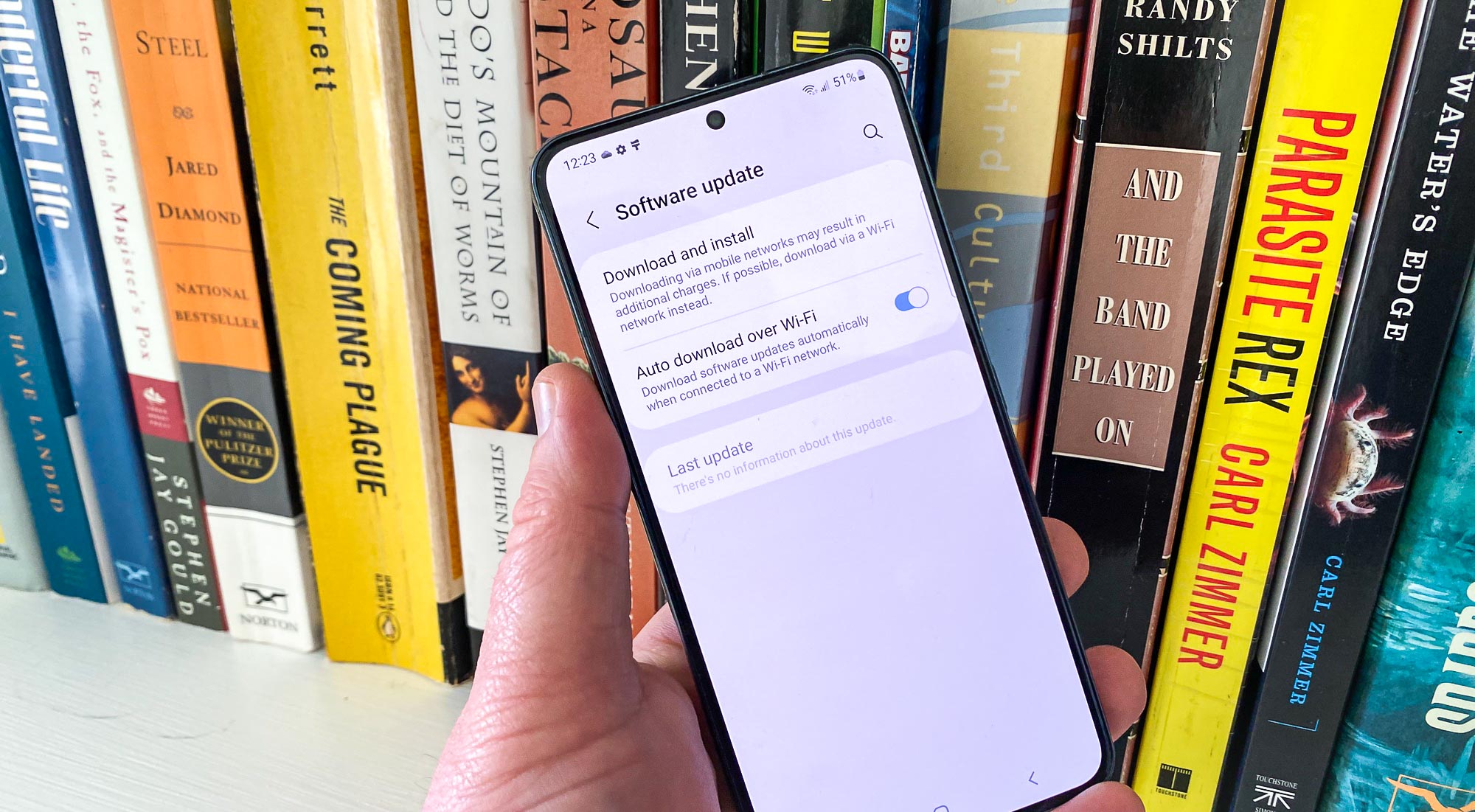
The real story here is Samsung's increased software support starting with the Galaxy S22. The phone maker now promises four years of Android software updates in addition to five years of security support. That brings the Galaxy S22 closer to Apple's level of lengthy support than any other Android phone maker. Even better, Samsung is extending those four years of Android updates to last year's flagships (which, perhaps ironically, will make Galaxy S21 owners even less willing to upgrade to this year's model).
One other thing to take note of is the fingerprint sensor on the Galaxy S22, which is right under the display as it is on previous Samsung models. I found the sensor very responsive and easy to locate — there's no delay or frequent misreads like the kind I have to endure when using the Pixel 6. And you won't find a fingerprint reader at all on iPhones of recent vintage, so Samsung really enjoys an edge here.
If you wind up getting a Galaxy S22, be sure to look at our guide to the S22 features to enable and disable right away. We've also got a look at the top hidden features on Samsung phones, including the S22.
Samsung Galaxy S22 review: How it compares to the Galaxy S23
We've mentioned some of the ways the Galaxy S23 beats out Samsung's older phone in this Galaxy S22 review, and our Galaxy S23 vs. Galaxy S22 comparison goes into additional detail on the differences. But to sum up, the biggest changes you'll miss out on if you opt for the cheaper S22 are the better performance and battery life that the Snapdragon 8 Gen 2 delivers.
Yes, the Galaxy S23 display is bright — but so is the S22 panel. And the two phones essentially have the same rear camera setup, so there's not much difference between photos. (The S23 is a little stronger when it comes to night photography.) Essentially, in choosing between these two Samsung phones, you need to decide if the faster processor and longer battery life is worth the extra $100 that the Galaxy S23 costs.
Samsung Galaxy S22 review: Verdict
No one would consider the Galaxy S22 a big leap forward for Samsung's phones, though I'm not sure it really needs to be. The fact that Samsung is extending software support for an extra year suggests the phone maker knows people are holding on to phones longer and that anyone with last year's Galaxy S21 is unlikely to be eyeing an upgrade.
Instead, the Galaxy S22 seems aimed at people who have older phones — at least two years old, though people still using a phone from 2019 or earlier will see the biggest improvements when they upgrade to the Galaxy S22. This is a solid step ahead for Samsung, with the improvements to the display and the camera particularly noticeable.
As to Samsung's claim on the title of best phone, the Galaxy S23 devices led by the Galaxy S23 Ultra have a much better claim on the title than this older phone. A year after its release, the Galaxy S22 is no longer Samsung's latest and greatest device, but it's still a good option for people who want flagship features at a lower price. On that front, Samsung more than delivers what you're asking for.
Philip Michaels is a Managing Editor at Tom's Guide. He's been covering personal technology since 1999 and was in the building when Steve Jobs showed off the iPhone for the first time. He's been evaluating smartphones since that first iPhone debuted in 2007, and he's been following phone carriers and smartphone plans since 2015. He has strong opinions about Apple, the Oakland Athletics, old movies and proper butchery techniques. Follow him at @PhilipMichaels.
